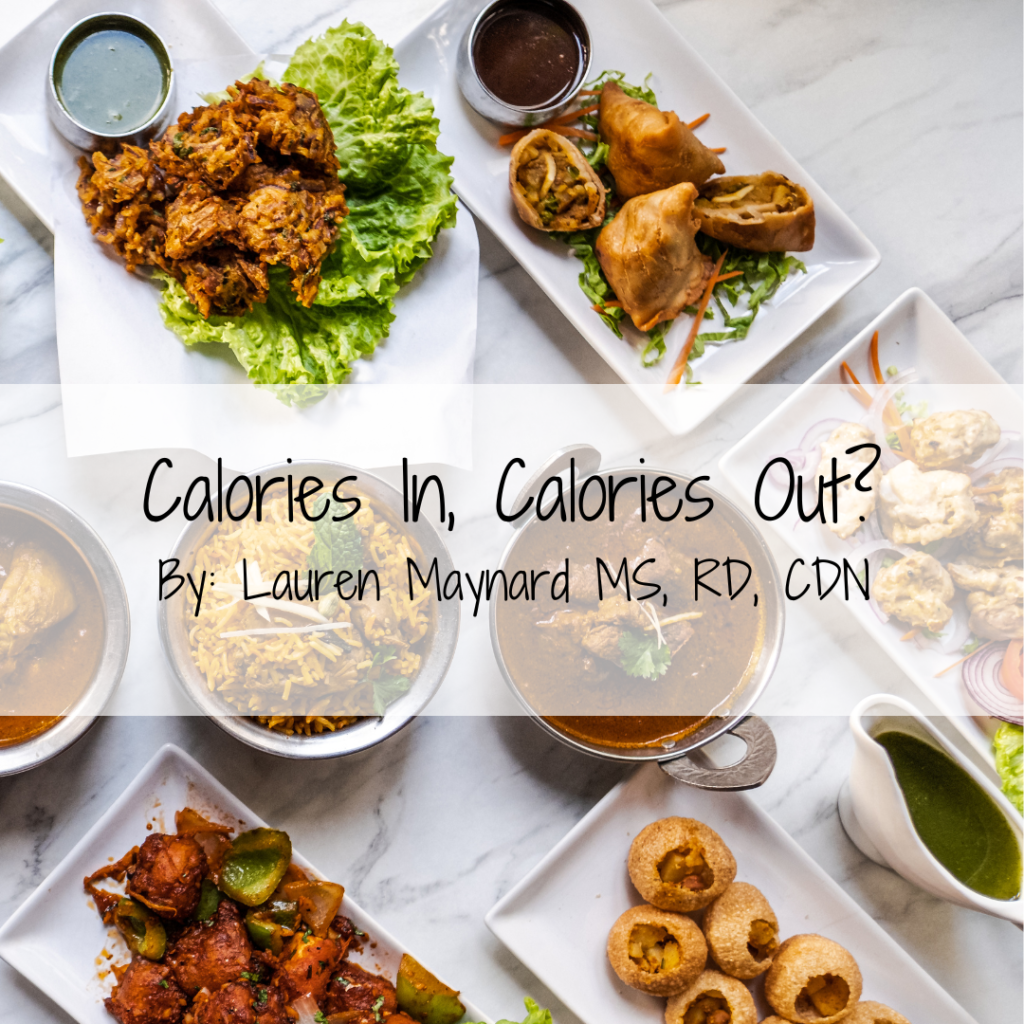
I am going to make the assumption that everyone reading this post at some point has been told that calories in food matter. You’ve likely heard they matter so much we should be tracking them daily. Heck, the font size for calories on food labels increased in 2020, just to make sure they were better seen! The truth is, most dietitians in the non-diet space honestly advise against this. Research shows hyper focusing on calories can lead to disordered eating and eating disorders, which both come with physical and mental health risks of their own.
Counting calories for weight control comes up almost daily in our work with clients and hopefully this post can update some of the science for you and shed some light on why a lot of dietitians have shifted against this. *If you are thinking that macro counting feels different and would like to learn more about that, check on this post here.
What is a calorie? Let’s start off with some good ole definitions. The word calorie means the amount of energy within a substance. More specifically, the amount of energy needed to raise 1 gram of water 1 degree Celsius. Do we need to memorize that? Probably not but what is important to know is that all of our organs and tissues are made up of billions of cells that require calories (energy) to keep us alive and well each day.
Some examples of these organs/tissues include:
- Liver
- Heart
- Kidneys
- Brain
- Skeletal muscles (quadriceps, triceps, biceps etc) and smooth muscles (stomach, small intestine, large intestine)
- Skin
- Bones
- Fatty tissue
So, our entire body.
The history of calories .. stay with me Calories were first explored in the 1800s through the use of a machine called a bomb calorimeter. This allowed researchers to better understand the amount of energy coming from the foods we eat, more specifically protein, carbohydrates, and fat. This device will basically blow up a piece of food and measure how much the surrounding water temperature rises which tells us how much energy (calories) were released from the explosion. From that data, it was then assumed humans must absorb this amount of energy from each food they tested. This gave us the math most of us dietitians learn in college: 4 calories/gram of carbohydrate, 4 calories/gram of protein and 9 calories/gram of fat. It also led to the development of education tools such as a food label for the general public to see these numbers. The public health goal was to provide a more standardized way to view each food and to offer guidance on how much energy each human needs daily. Isn’t it funny we assumed each person was identical and would need a standard 2000 calories each day? It seemed pretty straightforward and numbers tend to make us feel confident/safe, so it stuck. If you love learning and want to know more about this history of 2000 calories on a label, check out this post written by dietitian, Rachel Hartley.
Here’s why the science doesn’t add up anymore in 2023… Even though numbers feel definitive, they are not the whole story and humans are not bomb calorimeters. Having a general idea of how many calories are in a food does not guarantee how our body will digest and utilize the calories within food. This is why dieting and calorie counting can feel so frustrating! Two people could eat the same exact way but their bodies will use that energy very differently due to a few things:
- Genetics
- Metabolism
- Gut microbiota
- Digestion & Absorption
- Non-Exercise Activity Thermogenesis (NEAT)
Genetics are like the individual blueprints we all have for our bodies. Our genetics tend to predetermine a comfortable set point weight for us which is where we function our best. That doesn’t mean that calories do not influence someone’s body weight at all, they do. Restricting, overeating, or in any way fighting against the body’s desired set point can be a fruitless pursuit. Most people do not lacking willpower, they’re just fighting the wrong fight!
Metabolism is a fascinating topic. Our metabolic rate is determined by a lot of variables from the energy needed to regulate our internal systems (temperature, blood pressure, heart rate, breathing) to the amount of muscle we have, to our sleep patterns and stress levels. If you consume less food in comparison to what you’re burning your metabolism will slow, if you eat more food, your metabolism will speed up. We’ll talk about this more shortly.
The gut microbiota are the microorganisms (like bacteria) we have throughout our digestive system, primarily the large intestine/colon. There is fascinating research that shows pending someone’s diversity of gut bacteria, nutrients are absorbed differently. So again two people could eat the same meal and absorb different amounts of nutrients based on these little bacteria. Wild!
Digestion and absorption can impact energy availability in many ways depending on the types of foods consumed and the health of the individual. For example, someone with a gastrointestinal disease such as Celiac disease or SIBO may struggle to digest and absorb calories in the foods they consume. The content of foods, for example foods higher in fiber, can also alter the amount of calories we absorb.
Non-Exercise Activity Thermogenesis or NEAT are daily movements which are not intentional exercise. This can include things like getting out of bed and walking to your kitchen or unintentional movements such as fidgeting, leg bouncing, or standing. Some naturally have a higher NEAT than others.
These factors are very individualistic to each of us! This is a huge reason why general dieting recommendations do not lead to promised outcomes for the short or long term because humans are so much more complex than input and output.
Calories in, Calories out Let’s get into the deficit conversation a bit more. We’ve all heard that in order to modify body weight, understanding the balance of what we eat compared to what we “burn” is the top priority. Calories in, calories out describes this concept, where a person may try to consume more or less than they “burn” in order to manipulate body weight. We have an array of options when it comes to tracking our calories in (ie. My Fitness Pal, Cronometer) and our calories out (ie Apple watches, Fitbit etc) to try and support this goal. However, we are not machines and just because we log/track everything does not mean that is 100% accurate or will lead to a certain outcome!
Let’s take calories on a food label for example. Have you ever noticed they always end in a nice round number? This is because the calories on a label typically do not reflect the actual caloric value of the food. The FDA allows for a 20% margin of error on a food label which means that 200 calorie granola bar you are eating could actually be anywhere from 160 to 240 calories. Additionally, if you’re counting calories it’s pretty easy to forget to add every last bite. Did you remember that Hershey kiss you picked up from your co-workers desk? What about the bite of food your husband offered you from the dinner he ordered? Counting every last morsel, or avoiding those morsels to avoid tracking, can be tiresome and take the enjoyment out of food and life.
On the calories out side of the equation, there is a wide variety in the quality of trackers and therefore how accurate the information they provide. Additionally, factors such as your own height, weight, age, sex, and fitness level can impact how many calories are burned during a given exercise. For example, if a 6’ 4” 300 lb professional football player and a 5’2” 120 lb sedentary woman were both to run 1 mile, the amount of calories burned would be different. Trackers are notoriously incorrect, and people often over estimate the number of calories burned in a given equation.
So, we aren’t bomb calorimeters able to fully extract calories via an explosion. Our metabolism, genetics, NEAT etc. play a role in how we utilize the energy we consume.. We breathe in oxygen and exhale carbon dioxide, we absorb nutrients and excrete waste (poop), and have differences in our day to day activities and bodily functions. As a result, our energy requirement (calories in) cany change acutely day to day based on activity as well as over the long term based on various phases of life (adolescence, growth, pregnancy, physical fitness, age, illness). It’s far more complex than taking an apple and making it explode to know precisely what it does for us. It’s also important to remember that we eat for far more than just macronutrients – micronutrients (vitamins/minerals), fiber and hydration are hugely important for our health as human beings! So again, this isn’t to say energy coming in is impossible to understand or pointless to consider or utilize in select situations, it just gives us some breathing room to recognize we are so much more.
More on calorie deficits: I cannot emphasize this enough but it is next to impossible to be in a calorie deficit and still increase lean body mass or muscle. Read more on the under fueled athlete and health concerns here. If you are an active individual wanting to find strength improvements in your workouts, improve in your sport, an adolescent/parent of an adolescent wanting to support normal growth, or just a human being wanting to best support your health, simply eating less isn’t the best answer. The body’s job is to keep us alive! It doesn’t know why we may be in a deficit, all it recognizes is if this continues, we could die. The body will then adapt to reducing in the amount of energy we need to survive (ie slows metabolism). It’s a pretty fascinating survival mechanism and unfortunately the reason why the loss of a period, reduced bone density, and reduced muscle mass occur in a person who is under nourishing themselves. If you are a person in a larger body, please do not think that does not apply to you. It is still possible to have a loss of or reduced muscle mass and malnutrition regardless of size. If you are restricting, this will be a problem.
A great example of metabolic adaptation was seen in studying some of The Biggest Loser contestants. A majority of these contestants had such significant weight loss during the show that they found in order to maintain this loss they would have had to continuously eat less and less, while moving more and more. This is not realistic or appropriate for health. Weight regain after loss is very common due to a combination of factors but a large part of this is loss of lean muscle mass and metabolism shifting, NOT someone lacking self-control. When such high amounts of weight are lost, a large part of that is lean body mass or muscle, which most are not intentionally trying to lose.
I like this analogy from Rachel Hartley, RD: think about how your phone goes in low battery mode when it needs to conserve battery life – our body does the same thing. Our vital organs and systems (ie heart beating) require a ton of energy each day. Most people think creating a deficit will lead to guaranteed weight loss but the scale may or may not change. If weight loss does happen, as an RD I always want to know: what behavior changes occurred, were there any complete food groups eliminated (ie carbs), any physical activity changes, any physical (ie digestive, dizziness, fatigue) or mental health (ie anxiety, depression) symptom changes. This tells us a lot more about any metabolic concerns or longevity of the weight loss.
Takeaways
So, should I look at a food label? It is important to remember that a food label is only part of the story. It’s telling us the best information we have about what is in a food. But food is not just it’s calorie content. Food also contains vitamins, minerals, fiber, and phytonutritients. Taking the lens of “what can it offer me” vs “what should limit/avoid” is a much more supportive approach. Lacking appropriate nutrients can lead to poor health outcomes, regardless of weight. Simply reducing energy may lead to a reduction in really important micronutrients as well! Food labels provide limited information regarding vitamins and minerals. The only nutrients required on a food label are vitamin D, potassium, calcium, and iron. Food labels can be helpful to check nutrients that may be relevant to your particular health situation. For example, if you are someone that struggles with IBS or constipation you may want to peek at labels to choose products that have a higher fiber content. Or you could be someone dealing with kidney disease that needs to be mindful of your sodium intake. If you are someone that struggles with disordered eating, we encourage you to be extremely cautious about using food labels. Talk with your dietitian about what information you’re trying to receive by looking at food labels and if this is serving your recovery-oriented self or the eating disorder.
If you are looking at the calories, it’s also important to consider what you may need in that moment. 200 calories of sour patch kids vs 200 calories of peanut butter is drastically different! Peanut butter gives us energy from a mix of fat, protein, and carbohydrate and also includes fiber, vitamins and minerals whereas sour patch kids give us primarily energy from carbohydrate only. The sour patch kids may be a great option if you are in need of a quick source of energy with little GI upset like if you were pre or post exercise or had low blood sugar but it wouldn’t sustain you for long. This is why it’s important to avoid demonizing foods and instead consider them all to have a time and place for utility. And sometimes that utility is just enjoyment!
How do I trust hunger cues without tracking? It can take some time to learn to step away from counting calories and instead trust your body’s internal cues. If we are only thinking about calories in, calories out and ignoring any body cues, we may start to feel anxious, concerned or lose trust in our bodies. We may also feel obligated to eat less/restrict or move our body more if we do listen to these cues. This can lead down a path of disordered eating behaviors and potentially an eating disorder. Get curious. Our bodies are designed to communicate to us. Learning how to appropriately fuel our bodies, listen to hunger cues and really dig into what we know about science is how we can make sure we’re nourishing ourselves correctly. Kelly Ogdon, MS, RD, CDN writes on satisfaction and listening to satisfaction can be helpful in learning how to rebuild body trust.
What if another practitioner told me to eat less and exercise more to lose weight? If a practitioner has recommended this change, it can be really helpful to also work with a dietitian to better understand why this recommendation may have been made plus dive deeper into what your current eating/exercise patterns look like while talking about all of the individualistic things we discussed in this article. For example, a provider may have recommended weight loss as a way to control blood sugar. Working with a RD to increase fiber intake and adjust the timing of physical activity in relationship to a meal can lead to drastic improvements in blood sugar levels- even without weight loss.
Ultimately, we are likely going to see and hear about calories for a long time and I want you to be able to approach your nutrition choices with as much information as possible. If you do choose to use the calorie information on food labels or happen to see it when you are out to eat, remember that it is one piece of information not all of the information and get curious. If something is labeled as “low calorie” or you find yourself looking for the lowest number option, ask yourself: why you are always aiming for the lowest amount? Is this serving you in this moment? What if your hunger level doesn’t align with having the lowest calorie option? The less gas we put in a car the shorter distance we can go. Again, get curious. All foods can fit in a supportive way when we give them more power than numbers!
If you’d like to work with one of our dietitians, email [email protected] to get started. We can’t wait to meet you!
https://www.rachaelhartleynutrition.com/blog/what-are-you-missing-out-on-by-dieting
https://www.rachaelhartleynutrition.com/blog/debunking-the-3500-calories-in-a-pound-of-fat-rule


